Remote Screening for Developmental Language Disorder in Bilingual Children: Preliminary Validation in Spanish–Italian Speaking Preschool Children
Abstract
1. Introduction
1.1. Background
1.2. Rationale and Research Goals
- Construct and convergent validity will be assessed through the correlations between standardised and screening tests and questionnaires assessing the same or similar abilities.
- The diagnostic accuracy of the experimental battery will be exploratorily investigated through the analysis of the different receiver operating characteristic (ROC) curves. With ROC curves, we will distinguish the clinical condition vs. typical language acquisition, allowing for the definition of ideal cut-off points for the single tasks. To this end, the Youden index (J) will be considered. The parameters describing the ROC curves of the total screening battery as well as those of the single tasks will be taken as indexes of discriminant validity.
2. Materials and Methods
2.1. Participants
2.2. MuLiMi Platform and Tasks
2.2.1. Nonword Repetition Task
2.2.2. Cross-Linguistic Lexical Tasks
2.2.3. Who Says It Right?
2.2.4. Dynamic Novel Word Learning
2.3. Standardised Tests
2.4. Questionnaires [75]
2.5. Procedure
2.6. Data Analysis
3. Results
3.1. Overall Screening Score
3.2. Results of the Nonword Repetition Task
3.3. Results of the Cross-Linguistic Lexical Tasks
3.4. Results of the Subject-Verb Agreement Tasks
3.5. Results of the Finiteness Tasks
3.6. Results of the Dynamic Novel Word Learning Task
4. Discussion
5. Conclusions
Author Contributions
Funding
Institutional Review Board Statement
Informed Consent Statement
Data Availability Statement
Acknowledgments
Conflicts of Interest
Appendix A
| NW Category | NWs Selected |
|---|---|
| LS IT | [ˈmudjo], [fɔlˈda:na], [blanˈdjeza], [maŋkeˈtale] |
| NLS | [fulsɑmit], [melinɑk] |
| LS SP | [ˈxaɲo], [ˈnwelo], [ˈlaxo], [ajukomˈjon] |
| Item Category | Introductory Sentence | SVA | FIN |
|---|---|---|---|
| Italian example correct | “Chi lo dice giusto?” [Who says it right?] | “Io metto la sciarpa.” [I put on the scarf.] | “Lui corre veloce.” [He runs fast.] |
| Italian example incorrect | “Io mette* la sciarpa.” [I puts* on the scarf.] | “Lui correre* veloce.” [He runINF* fast.] | |
| Spanish example correct | “¿Quién lo dice bien?” [Who says it right?] | “Él duerme mucho.” [He sleeps a lot.] | “Ella cae siempre.” [She falls always.] |
| Spanish example correct | “Él duermen mucho.” [He sleepPL* a lot.] | “Ella caer* siempre.” [She fallINF* always.] |
| Score | Prime | Response |
|---|---|---|
| 1 point | no prime | target stimulus, or high overlap with target stimulus: minimum 3/5 phonemes—including all vowels |
| 0.5 points | initial sound prime | target stimulus, or high overlap with target stimulus: minimum 3/5 phonemes—including all vowels |
| 0 points | initial sound prime | no response, or response given differs from target stimulus in more than two out of five phonemes |
References
- Grosjean, F.; Li, P. The Psycholinguistics of Bilingualism; Wiley-Blackwell: Hoboken, NJ, USA, 2013. [Google Scholar]
- Stow, C.; Dodd, B. Providing an equitable service to bilingual children in the UK: A review. IJLCD 2003, 38, 351–377. [Google Scholar] [CrossRef] [PubMed]
- Istituto Nazionale di Statistica. Il Censimento Permanente della popolazione in Lombardia. 2021. Available online: https://www.istat.it/it/archivio/253434 (accessed on 1 March 2022).
- Marini, A.; Sperindè, P.; Ruta, I.; Savegnago, C.; Avanzini, F. Linguistic Skills in Bilingual Children with Developmental Language Disorders: A Pilot Study. Front. Psychol 2019, 10, 493. [Google Scholar] [CrossRef]
- Scharff Rethfeldt, W. Speech and Language Therapy Services for Multilingual Children with Migration Background: A Cross-Sectional Survey in Germany. Folia Phoniatr. Logop. 2019, 71, 116–126. [Google Scholar] [CrossRef] [PubMed]
- Stankova, M.; Rodríguez-Ortiz, I.R.; Matić, A.; Levickis, P.; Lyons, R.; Messarra, C.; Kouba Hreich, E.; Vulchanova, M.; Vulchanov, V.; Czaplewska, E.; et al. Cultural and Linguistic Practice with Children with Developmental Language Disorder: Findings from an International Practitioner Survey. Folia Phoniatr. Logop. 2021, 73, 465–477. [Google Scholar] [CrossRef]
- Garraffa, M.; Vender, M.; Sorace, A.; Guasti, M.T. Is it possible to differentiate multilingual children and children with Developmental Language Disorder? LSP 2019. [Google Scholar] [CrossRef]
- Bloder, T.; Eikerling, M.; Rinker, T.; Lorusso, M.L. Speech and Language Therapy Service for Multilingual Children: Attitudes and Approaches across Four European Countries. Sustainability 2021, 13, 12143. [Google Scholar] [CrossRef]
- Grimm, A.; Schulz, P. Specific Language Impairment and Early Second Language Acquisition: The Risk of Over- and Underdiagnosis. Child Indic. Res. 2014, 7, 821–841. [Google Scholar] [CrossRef]
- Eikerling, M.; Lorusso, M.L. A web-platform for DLD screening in Italian-German-speaking children: Preliminary data on concurrent and predictive validity. Lingue Ling. 2022, 1, 193–212. [Google Scholar] [CrossRef]
- Eikerling, M.; Secco, M.; Marchesi, G.; Guasti, M.T.; Vona, F.; Garzotto, F.; Lorusso, M.L. Remote Dyslexia Screening for Bilingual Children. MTI 2022, 6, 7. [Google Scholar] [CrossRef]
- Eikerling, M.; Bloder, T.; Lorusso, M.L. A Nonword Repetition Task Discriminates Typically Developing Italian-German Bilingual Children From Bilingual Children With Developmental Language Disorder: The Role of Language-Specific and Language-Non-specific Nonwords. Front. Psychol. 2022, 13, 826540. [Google Scholar] [CrossRef]
- Tomblin, J.B.; Records, N.L.; Buckwalter, P.; Zhang, X.; Smith, E.; O’Brien, M. Prevalence of specific language impairment in kindergarten children. JSLHR 1997, 40, 1245–1260. [Google Scholar] [CrossRef] [PubMed]
- Norbury, C.F.; Gooch, D.; Wray, C.; Baird, G.; Charman, T.; Simonoff, E.; Vamvakas, G.; Pickles, A. The impact of nonverbal ability on prevalence and clinical presentation of language disorder: Evidence from a population study. J. Child Psychol. Psychiatry 2016, 57, 1247–1257. [Google Scholar] [CrossRef] [PubMed]
- World Health Organization. 6A01.2 Developmental Language Disorder. In ICD-11 for Mortality and Morbidity Statistics; WHO: Geneva, Switzerland, 2022. [Google Scholar]
- Bishop, D.V.M.; Snowling, M.J.; Thompson, P.A.; Greenhalgh, T. Phase 2 of CATALISE: A multinational and multidisciplinary Delphi consensus study of problems with language development: Terminology. J. Child Psychol. Psychiatry 2017, 58, 1068–1080. [Google Scholar] [CrossRef] [PubMed]
- Snowling, M.J.; Bishop, D.V.M.; Stothard, S.E.; Chipchase, B.; Kaplan, C. Psychosocial outcomes at 15 years of children with a preschool history of speech-language impairment. J. Child Psychol. Psychiatry 2006, 47, 759–765. [Google Scholar] [CrossRef] [PubMed]
- Snowling, M.J.; Nash, H.M.; Gooch, D.C.; Hayiou-Thomas, M.E.; Hulme, C. Developmental Outcomes for Children at High Risk of Dyslexia and Children with Developmental Language Disorder. Child Dev. 2019, 90, e548–e564. [Google Scholar] [CrossRef] [PubMed]
- Johnson, C.J.; Beitchman, J.H.; Brownlie, E.B. Twenty-year follow-up of children with and without speech-language impairments: Family, educational, occupational, and quality of life outcomes. AJSLP 2010, 19, 51–65. [Google Scholar] [CrossRef] [PubMed]
- Tomblin, J.B. Familial concentration of developmental language impairment. JSHD 1989, 54, 287–295. [Google Scholar] [CrossRef]
- Gopnik, M.; Crago, M.B. Familial aggregation of a developmental language disorder. Cognition 1991, 39, 1–50. [Google Scholar] [CrossRef]
- Arrhenius, B.; Gyllenberg, D.; Chudal, R.; Lehti, V.; Sucksdorff, M.; Sourander, O.; Virtanen, J.-P.; Torsti, J.; Sourander, A. Social risk factors for speech, scholastic and coordination disorders: A nationwide register-based study. BMC Public Health 2018, 18, 739. [Google Scholar] [CrossRef]
- Boivin, M.J.; Kakooza, A.M.; Warf, B.C.; Davidson, L.L.; Grigorenko, E.L. Reducing neurodevelopmental disorders and disability through research and interventions. Nature 2015, 527, S155–S160. [Google Scholar] [CrossRef]
- Sansavini, A.; Favilla, M.E.; Guasti, M.T.; Marini, A.; Millepiedi, S.; Di Martino, M.V.; Vecchi, S.; Battajon, N.; Bertolo, L.; Capirci, O.; et al. Developmental Language Disorder: Early Predictors, Age for the Diagnosis, and Diagnostic Tools. A Scoping Review. Brain Sci. 2021, 11, 654. [Google Scholar] [CrossRef] [PubMed]
- Paradis, J.; Crago, M.; Genesee, F.; Rice, M. French-English bilingual children with SLI: How do they compare with their monolingual peers? JSLHR 2003, 46, 113–127. [Google Scholar] [CrossRef] [PubMed]
- Paradis, J. The Development of English as a Second Language With and Without Specific Language Impairment: Clinical Implications. JSLHR 2016, 59, 171–182. [Google Scholar] [CrossRef] [PubMed]
- Lehti, V.; Gyllenberg, D.; Suominen, A.; Sourander, A. Finnish-born children of immigrants are more likely to be diagnosed with developmental disorders related to speech and language, academic skills and coordination. Acta Paediatr. 2018, 107, 1409–1417. [Google Scholar] [CrossRef] [PubMed]
- Cummins, J.; The role of Primary Language Development in Promoting Educational Success for Language Minority Students. Schooling and Language Minority Students. A Theoretical Framework. 1981. Available online: https://files.eric.ed.gov/fulltext/ED249773.pdf (accessed on 3 November 2021).
- Cummins, J. The Cross-Lingual Dimensions of Language Proficiency: Implications for Bilingual Education and the Optimal Age Issue. TQ 1980, 14, 175. [Google Scholar] [CrossRef]
- De Lamo White, C.; Jin, L. Evaluation of speech and language assessment approaches with bilingual children. IJLCD 2011, 46, 613–627. [Google Scholar] [CrossRef]
- Bedore, L.M.; Peña, E.D.; García, M.; Cortez, C. Conceptual versus monolingual scoring: When does it make a difference? LSHSS 2005, 36, 188–200. [Google Scholar] [CrossRef]
- Werker, J.F.; Hensch, T.K. Critical periods in speech perception: New directions. Annu. Rev. Psychol. 2015, 66, 173–196. [Google Scholar] [CrossRef]
- Kohnert, K.; Medina, A. Bilingual Children and Communication Disorders: A 30-Year Research Retrospective. Semin. Speech Lang. 2009, 30, 219–233. [Google Scholar] [CrossRef]
- Ebert, K.D.; Kohnert, K. Language learning impairment in sequential bilingual children. Lang. Teach. 2016, 49, 301–338. [Google Scholar] [CrossRef]
- Core, C.; Hoff, E.; Rumiche, R.; Señor, M. Total and conceptual vocabulary in Spanish-English bilinguals from 22 to 30 months: Implications for assessment. JSLHR 2013, 56, 1637–1649. [Google Scholar] [CrossRef] [PubMed]
- Contento, S.; Bellocchi, S.; Bonifacci, P. BaBIL: Prove per la Valutazione delle Competenze Verbali e Non-Verbali in Bambini Bilingui: Manuale e Materiali; Giunti O.S.: Florence, Italy, 2013. [Google Scholar]
- Peña, E.D.; Gutierrez-Clellen, V.; Iglesias, A.; Goldstein, B.; Bedore, L.M. BESA: Bilingual English-Spanish Assessment; Paul H. Brookes Publishing Co: Baltimore, MD, USA, 2018. [Google Scholar]
- Haman, E.; Łuniewska, M.; Hansen, P.; Simonsen, H.G.; Chiat, S.; Bjekić, J.; Blažienė, A.; Chyl, K.; Dabašinskienė, I.; Engel de Abreu, P.; et al. Noun and verb knowledge in monolingual preschool children across 17 languages: Data from Cross-linguistic Lexical Tasks (LITMUS-CLT). Clin. Linguist. Phon. 2017, 31, 818–843. [Google Scholar] [CrossRef] [PubMed]
- Haman, E.; Łuniewska, M.; Pomiechowska, B. 8. Designing Cross-Linguistic Lexical Tasks (CLTs) for Bilingual Preschool Children. In Assessing Multilingual Children: Disentangling Bilingualism from Language Impairment; Armon-Lotem, S., de Jong, J., Meir, N., Eds.; Communication Disorders Across Languages Multilingual Matters: Blue Ridge Summit, PA, USA, 2015; pp. 196–240. [Google Scholar]
- Warsaw University, Child Lexicon CLT (Version 1.0): Google Play. 2022. Available online: https://play.google.com/store/apps/details?id=pl.edu.uw.childlexiconclt&gl=PL (accessed on 12 September 2022).
- Rinker, T.; Bloder, T.; Plotner, K. Italian and German lexical development in Italian heritage speakers in kindergarten and elementary school settings. Lingue Ling. 2022, 21, 53–72. [Google Scholar] [CrossRef]
- Matrat, M.; Delage, H.; Kehoe, M. Dynamic Assessment of Word Learning to Diagnose Developmental Language Disorder in French-Speaking Monolingual and Bilingual Children. Languages 2022, 7, 181. [Google Scholar] [CrossRef]
- Hunt, E.; Nang, C.; Meldrum, S.; Armstrong, E. Can Dynamic Assessment Identify Language Disorder in Multilingual Children? Clinical Applications From a Systematic Review. LSHSS 2022, 53, 598–625. [Google Scholar] [CrossRef]
- Orellana, C.I.; Wada, R.; Gillam, R.B. The Use of Dynamic Assessment for the Diagnosis of Language Disorders in Bilingual Children: A Meta-Analysis. AJSLP 2019, 28, 1298–1317. [Google Scholar] [CrossRef] [PubMed]
- Gutiérrez-Clellen, V.F.; Peña, E. Dynamic Assessment of Diverse Children: A Tutorial. LSHSS 2001, 32, 212–224. [Google Scholar] [CrossRef] [PubMed]
- Camilleri, B.; Hasson, N.; Dodd, B. Dynamic Assessment of bilingual children’s language at the point of referral. Educ. Child Psychol. 2014, 2, 57–72. [Google Scholar] [CrossRef]
- Girbau, D. The Non-word Repetition Task as a clinical marker of Specific Language Impairment in Spanish-speaking children. First Lang. 2016, 36, 30–49. [Google Scholar] [CrossRef]
- Jackson, E.; Leitao, S.; Claessen, M. The relationship between phonological short-term memory, receptive vocabulary, and fast mapping in children with specific language impairment. IJLCD 2016, 51, 61–73. [Google Scholar] [CrossRef]
- Roseberry, C.A.; Connell, P.J. The Use of an Invented Language Rule in the Differentiation of Normal and Language-Impaired Spanish-Speaking Children. JSLHR 1991, 34, 596–603. [Google Scholar] [CrossRef] [PubMed]
- Kohnert, K.; Danahy, K. Young L2 learners’ performance on a novel morpheme task. Clin. Linguist. Phon. 2007, 21, 557–569. [Google Scholar] [CrossRef] [PubMed]
- Kan, P.F.; Kohnert, K. Fast mapping by bilingual preschool children. J. Child Lang. 2008, 35, 495–514. [Google Scholar] [CrossRef] [PubMed]
- Schwob, S.; Eddé, L.; Jacquin, L.; Leboulanger, M.; Picard, M.; Oliveira, P.R.; Skoruppa, K. Using Nonword Repetition to Identify Developmental Language Disorder in Monolingual and Bilingual Children: A Systematic Review and Meta-Analysis. JSLHR 2021, 64, 3578–3593. [Google Scholar] [CrossRef] [PubMed]
- Farabolini, G.; Rinaldi, P.; Caselli, M.C.; Cristia, A. Non-word repetition in bilingual children: The role of language exposure, vocabulary scores and environmental factors. Speech Lang. Hear. 2021, 25, 283–298. [Google Scholar] [CrossRef]
- Hoover, J.R.; Storkel, H.L. Using Nonword Repetition in Vocabulary Assessment. ACQuiring Knowledge in Speech, Language, and Hearing. Available online: https://kuscholarworks.ku.edu/handle/1808/19904 (accessed on 23 February 2022).
- Rispens, J.; Been, P. Subject-verb agreement and phonological processing in developmental dyslexia and specific language impairment (SLI): A closer look. IJLCD 2007, 42, 293–305. [Google Scholar] [CrossRef]
- Chiat, S. Non-Word Repetition. In Assessing Multilingual Children: Disentangling Bilingualism from Language Impairment; Armon-Lotem, S., de Jong, J., Meir, N., Eds.; Communication Disorders Across Languages Multilingual Matters: Blue Ridge Summit, PA, USA, 2015; pp. 125–150. [Google Scholar]
- Bortolini, U.; Caselli, M.C.; Leonard, L.B. Grammatical deficits in Italian-speaking children with specific language impairment. JSLHR 1997, 40, 809–820. [Google Scholar] [CrossRef]
- Bortolini, U.; Caselli, C.M.; Deevy, P.; Leonard, L.B. Specific language impairment in Italian: The first steps in the search for a clinical marker. IJLCD 2002, 37, 77–93. [Google Scholar] [CrossRef]
- Bortolini, U.; Arfé, B.; Caselli, C.M.; Degasperi, L.; Deevy, P.; Leonard, L.B. Clinical markers for specific language impairment in Italian: The contribution of clitics and non-word repetition. IJLCD 2006, 41, 695–712. [Google Scholar] [CrossRef]
- Dispaldro, M.; Leonard, L.B.; Deevy, P. Clinical markers in Italian-speaking children with and without specific language impairment: A study of non-word and real word repetition as predictors of grammatical ability. IJLCD 2013, 48, 554–564. [Google Scholar] [CrossRef]
- Guasti, M.T.; White, M.J.; Bianco, G.; Arosio, F.; Camilleri, B.; Hasson, N. Two clinical markers for DLD in monolingual Italian speakers: What can they tell us about second language learners with DLD? Clin. Linguist. Phon. 2021, 35, 829–846. [Google Scholar] [CrossRef] [PubMed]
- Vender, M.; Garraffa, M.; Sorace, A.; Guasti, M.T. How early L2 children perform on Italian clinical markers of SLI: A study of clitic production and nonword repetition. Clin. Linguist. Phon. 2016, 30, 150–169. [Google Scholar] [CrossRef] [PubMed]
- Bedore, L.M.; Leonard, L.B. Grammatical morphology deficits in Spanish-speaking children with specific language impairment. JSLHR 2001, 44, 905–924. [Google Scholar] [CrossRef] [PubMed]
- Grinstead, J.; Lintz, P.; Vega-Mendoza, M.; de La Mora, J.; Cantú-Sánchez, M.; Flores-Avalos, B. Evidence of optional infinitive verbs in the spontaneous speech of Spanish-speaking children with SLI. Lingua 2014, 140, 52–66. [Google Scholar] [CrossRef]
- Shin, S.Y. Web-based language testing. In The Cambridge Guide to Language Assessment; Coombe, C., O’Sullivan, B., Davidson, P., Stoynoff, S., Eds.; Cambridge University Press: Cambridge, UK, 2012. [Google Scholar]
- Davidson, P.; Coombe, C. Computerized language assessment. In The Cambridge Guide to Language Assessment; Coombe, C., O’Sullivan, B., Davidson, P., Stoynoff, S., Eds.; Cambridge University Press: Cambridge, UK, 2012. [Google Scholar]
- Finestack, L.H.; Rohwer, B.; Hilliard, L.; Abbeduto, L. Using Computerized Language Analysis to Evaluate Grammatical Skills. Lang. Speech Hear. Serv. Sch. 2020, 51, 184–204. [Google Scholar] [CrossRef]
- Motsch, H.-J. ESGRAF-MK: Mit 16 Abbildungen und 17 Tabellen: Mit Diagnostik-Software auf CD-ROM; Ernst Reinhardt Verlag: Munich, Germany, 2011. [Google Scholar]
- Horbach, J.; Scharke, W.; Cröll, J.; Heim, S.; Günther, T. Kindergarteners’ performance in a sound-symbol paradigm predicts early reading. J. Exp. Child. Psychol. 2015, 139, 256–264. [Google Scholar] [CrossRef]
- Horbach, J.; Weber, K.; Opolony, F.; Scharke, W.; Radach, R.; Heim, S.; Günther, T. Performance in Sound-Symbol Learning Predicts Reading Performance 3 Years Later. Front. Psychol. 2018, 9, 1716. [Google Scholar] [CrossRef]
- Braginsky, M. Wordbank Data. Available online: http://wordbank.stanford.edu/data?name=item_trajectories (accessed on 9 December 2022).
- Marini, A.; Marotta, L.; Bulgheroni, S.; Fabbro, F. BVL_4-12: Batteria per la Valutazione del Linguaggio in Bambini dai 4 ai 12 anni; Giunti O.S.: Florence, Italy, 2015. [Google Scholar]
- Vicari, S.; Marotta, L.; Luci, A. TFL Test Fono-Lessicale: Valutazione delle Abilità Lessicali in età Prescolare; Edizioni Erickson: Trento TN, Italy, 2007. [Google Scholar]
- Belacchi, C.; Scalisi, T.G.; Cannoni, E.; Cornoldi, C. Manuale CPM. Coloured Progressive Matrices. Standardizzazione Italiana; Giunti O.S. Organizzazioni Speciali: Firenze, Italy, 2008. [Google Scholar]
- Lorusso, M.L.; Dolzadelli, C. A Tool for Identification of Risk Status for DLD from 20 to 60 Months; Giornate Clasta VII: Calambrone, Italy, 2016. [Google Scholar]
- Lorusso, M.L. An e-health approach for early identificaction of atypical languge development. In Proceedings of the Neurodevelopmental Disorders in the First Three Years of Life Congress, Bosisio Parini, Italy, 27 October 2017. [Google Scholar]
- Hautala, J.; Heikkilä, R.; Nieminen, L.; Rantanen, V.; Latvala, J.-M.; Richardson, U. Identification of Reading Difficulties by a Digital Game-Based Assessment Technology. J. Educ. Comput. Res. 2020, 58, 1003–1028. [Google Scholar] [CrossRef]
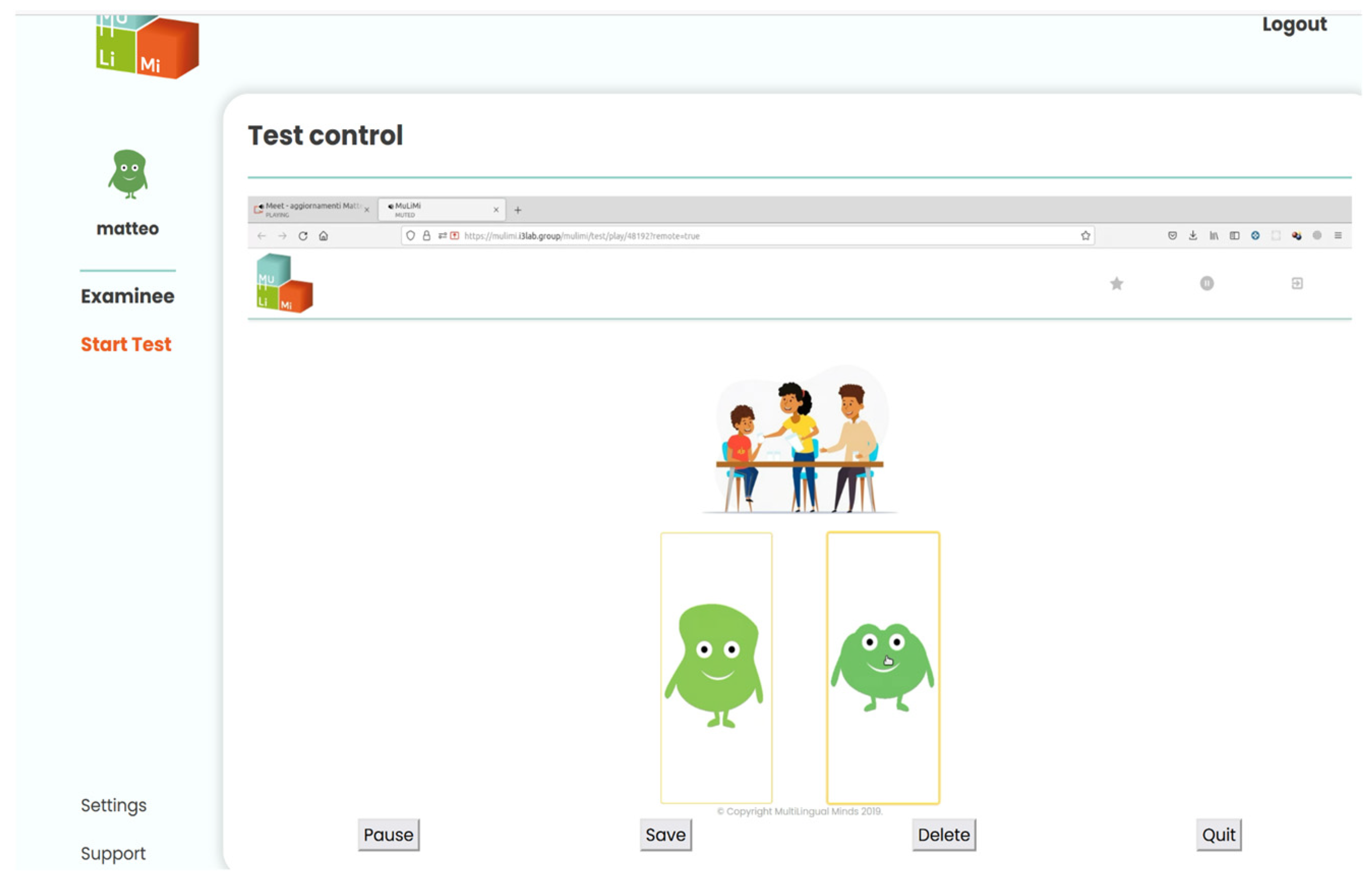
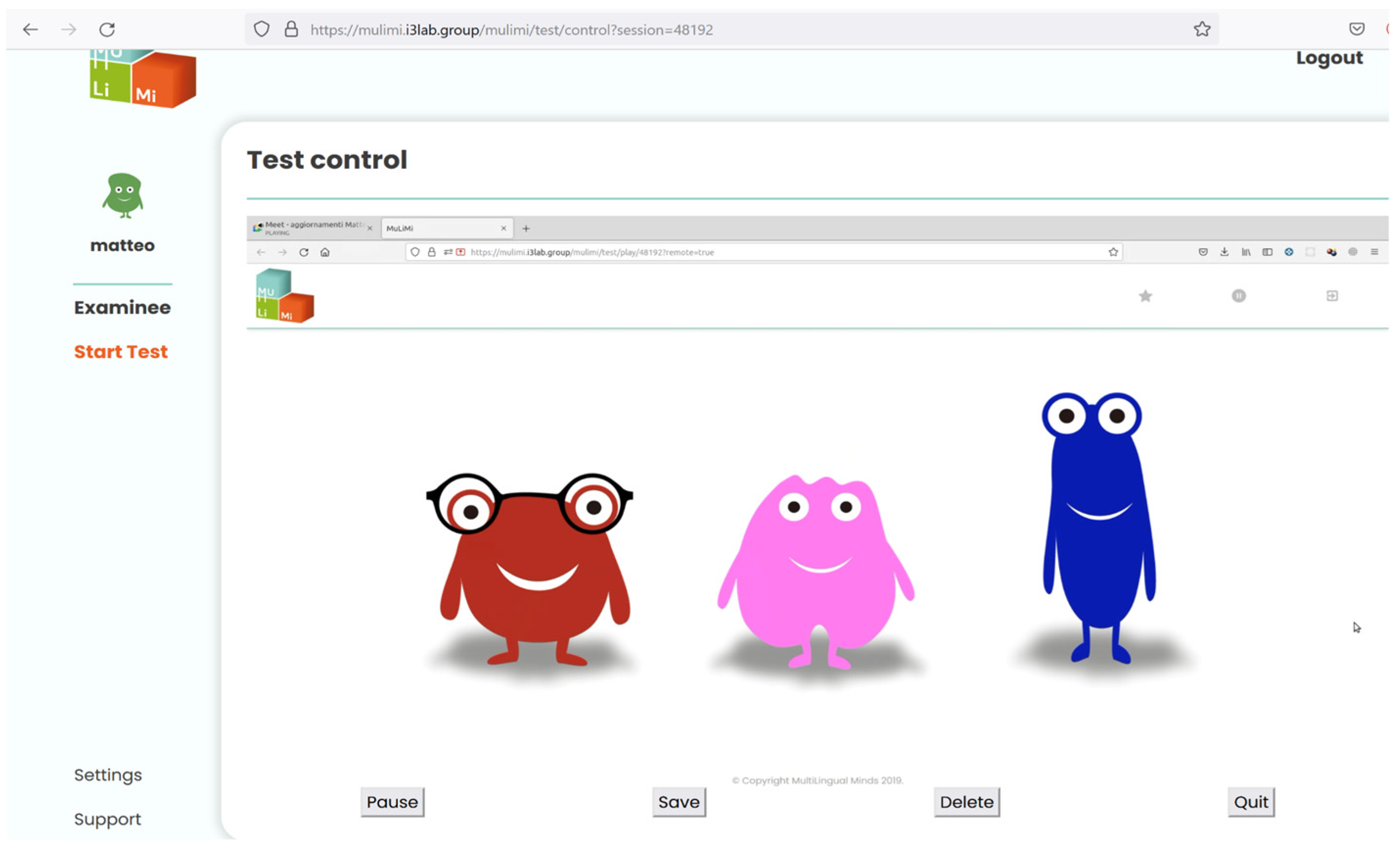
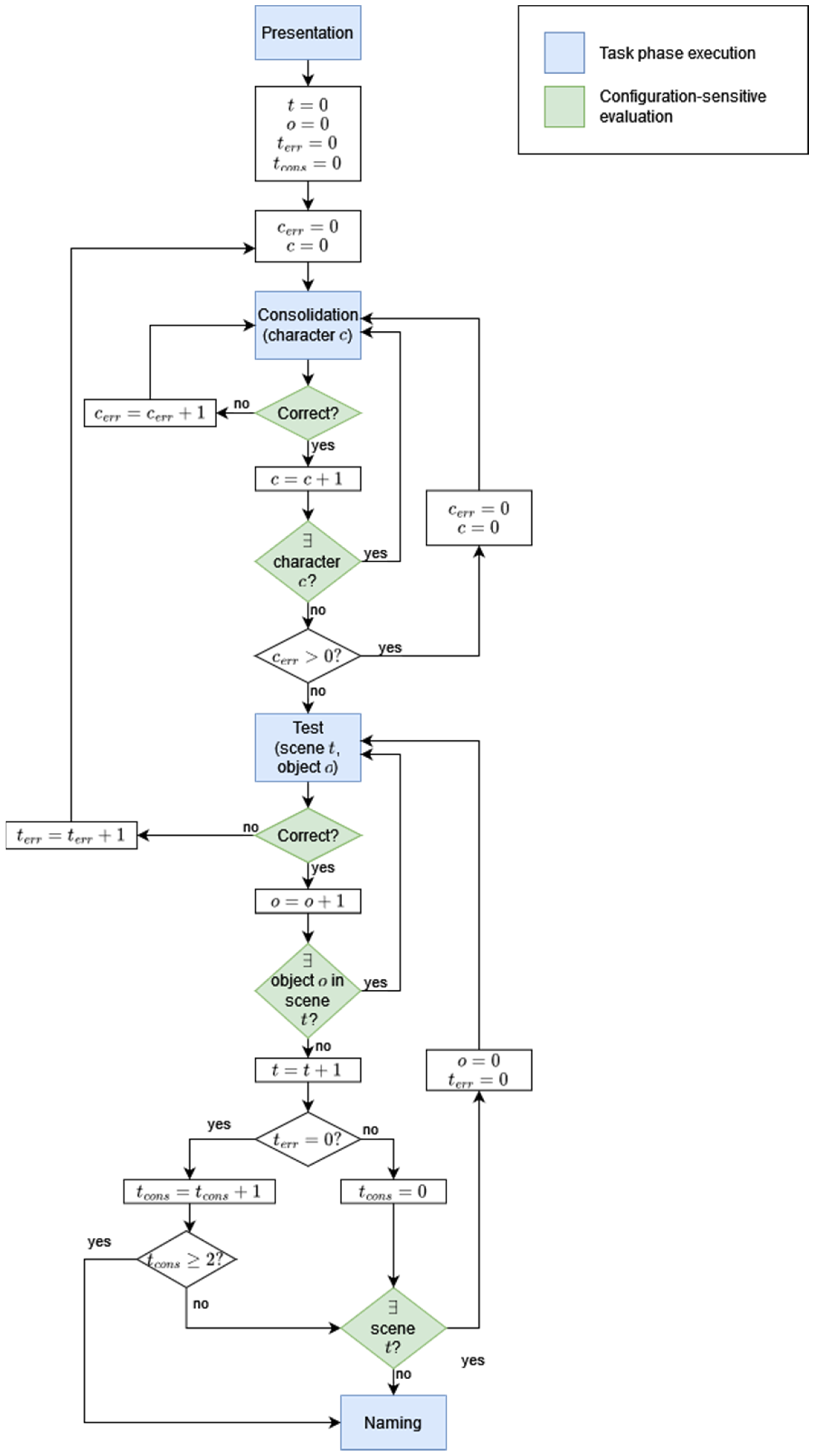



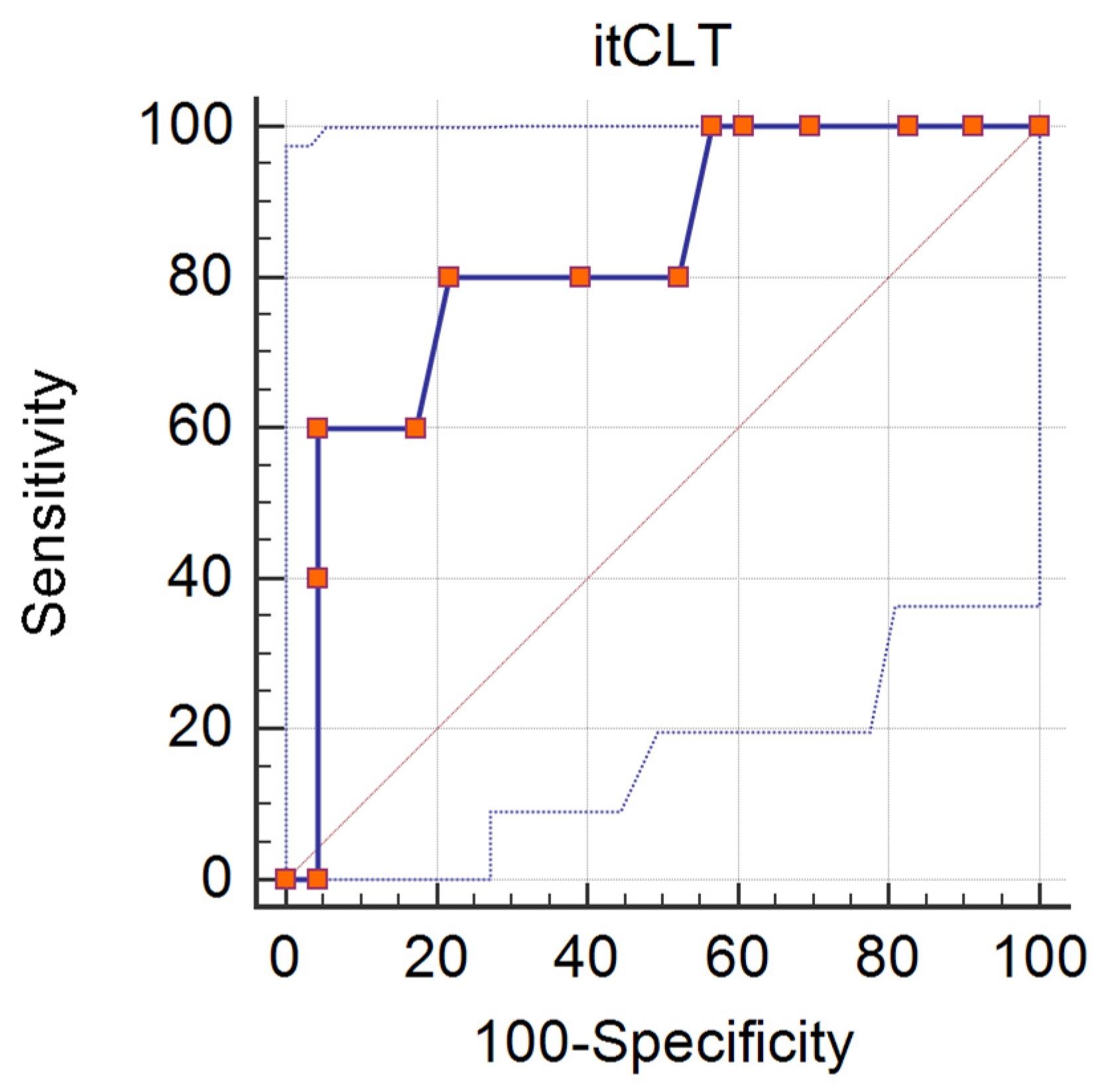

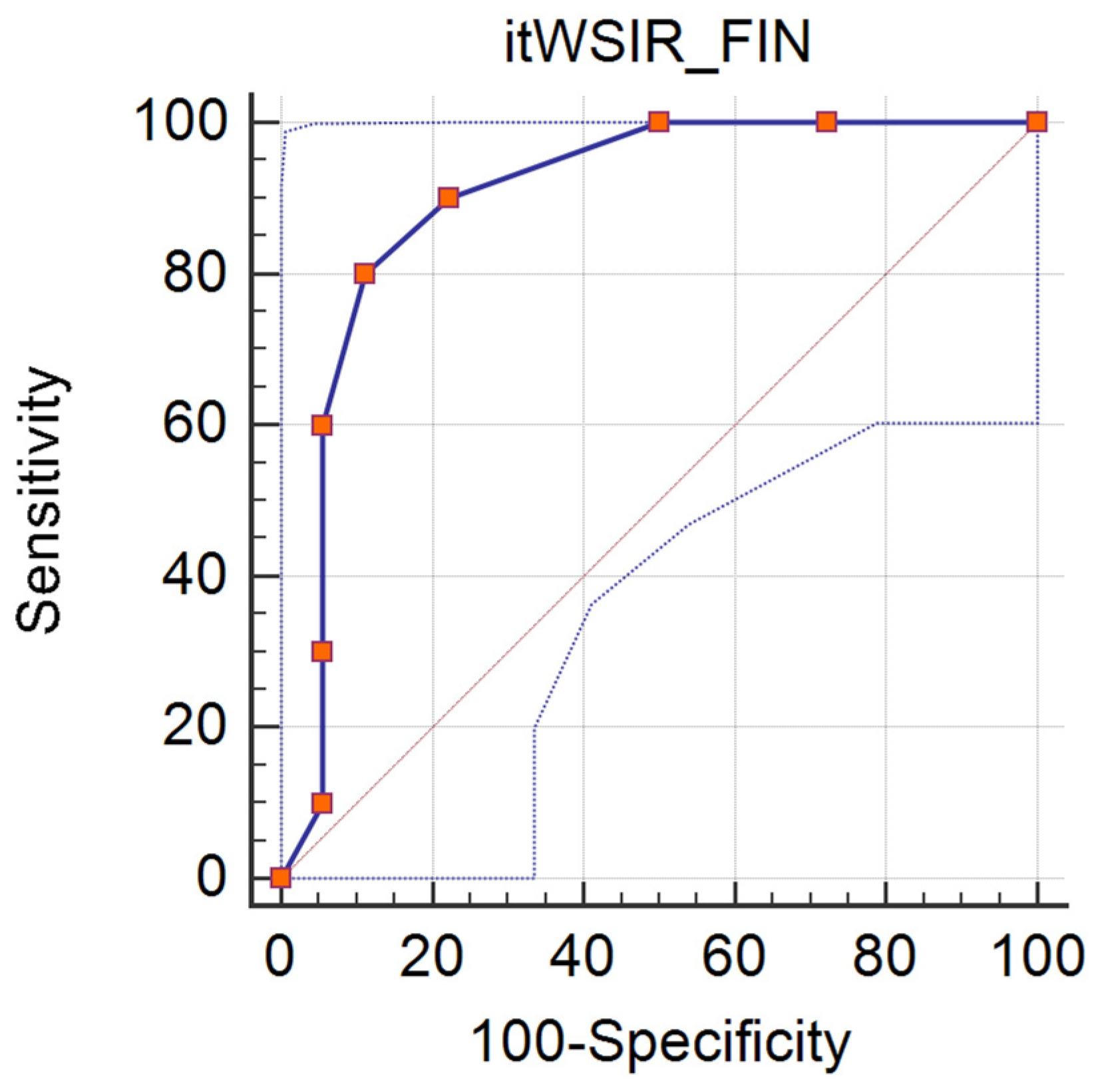
Disclaimer/Publisher’s Note: The statements, opinions and data contained in all publications are solely those of the individual author(s) and contributor(s) and not of MDPI and/or the editor(s). MDPI and/or the editor(s) disclaim responsibility for any injury to people or property resulting from any ideas, methods, instructions or products referred to in the content. |
© 2023 by the authors. Licensee MDPI, Basel, Switzerland. This article is an open access article distributed under the terms and conditions of the Creative Commons Attribution (CC BY) license (https://creativecommons.org/licenses/by/4.0/).
Share and Cite
Eikerling, M.; Andreoletti, M.; Secco, M.; Luculli, B.; Cha, G.; Castro, S.; Gazzola, S.; Sarti, D.; Garzotto, F.; Guasti, M.T.; et al. Remote Screening for Developmental Language Disorder in Bilingual Children: Preliminary Validation in Spanish–Italian Speaking Preschool Children. Appl. Sci. 2023, 13, 1442. https://doi.org/10.3390/app13031442
Eikerling M, Andreoletti M, Secco M, Luculli B, Cha G, Castro S, Gazzola S, Sarti D, Garzotto F, Guasti MT, et al. Remote Screening for Developmental Language Disorder in Bilingual Children: Preliminary Validation in Spanish–Italian Speaking Preschool Children. Applied Sciences. 2023; 13(3):1442. https://doi.org/10.3390/app13031442
Chicago/Turabian StyleEikerling, Maren, Marco Andreoletti, Matteo Secco, Bianca Luculli, Giulia Cha, Sofía Castro, Stefania Gazzola, Daniela Sarti, Franca Garzotto, Maria Teresa Guasti, and et al. 2023. "Remote Screening for Developmental Language Disorder in Bilingual Children: Preliminary Validation in Spanish–Italian Speaking Preschool Children" Applied Sciences 13, no. 3: 1442. https://doi.org/10.3390/app13031442
APA StyleEikerling, M., Andreoletti, M., Secco, M., Luculli, B., Cha, G., Castro, S., Gazzola, S., Sarti, D., Garzotto, F., Guasti, M. T., & Lorusso, M. L. (2023). Remote Screening for Developmental Language Disorder in Bilingual Children: Preliminary Validation in Spanish–Italian Speaking Preschool Children. Applied Sciences, 13(3), 1442. https://doi.org/10.3390/app13031442








